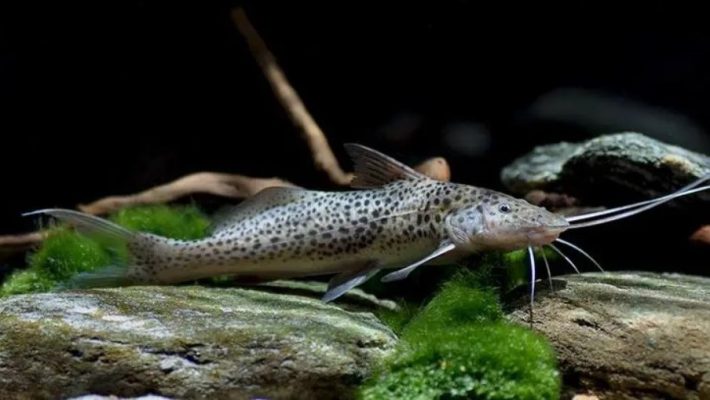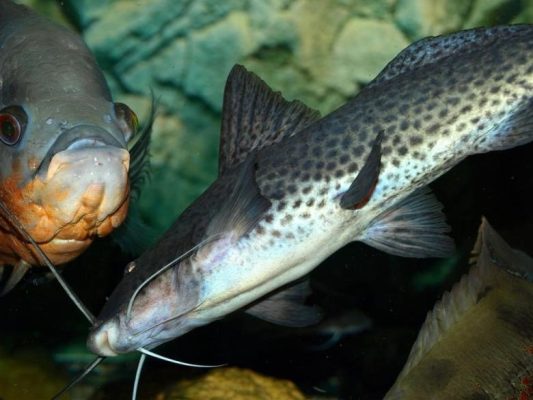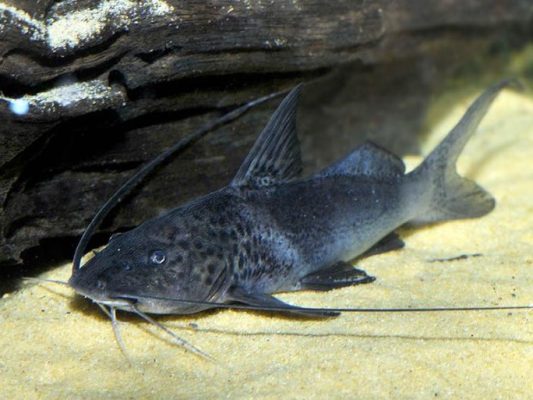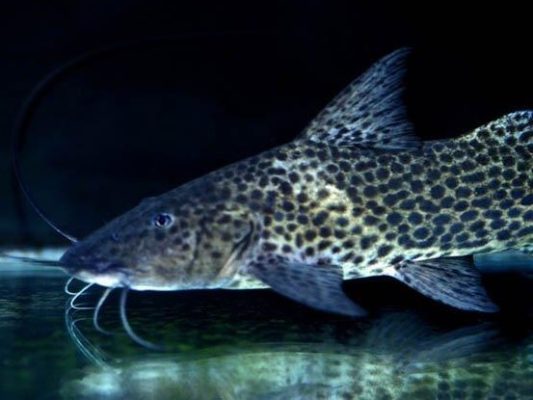Bolt Catfish

Table of Contents
- Introduction
- Taxonomy and Classification
- Habitat and Distribution
- Physical Characteristics
- Behavior and Reproduction
- Conclusion
Introduction
The Bolt catfish, scientifically known as Aguarunichthys torosus, is a remarkable species that captivates the attention of fish enthusiasts and aquarists alike. With its unique characteristics and desirability, the Bolt catfish stands out among other freshwater species.
This species has gained popularity due to its striking appearance and fascinating behavior. The Bolt catfish possesses a sleek body adorned with intricate patterns and vibrant colors, making it a visually appealing addition to any aquarium. Its distinct characteristics, such as its elongated body and prominent pectoral fins, further contribute to its allure.
The Bolt catfish plays a crucial role in maintaining a balanced aquatic ecosystem. As a bottom-dwelling species, it actively contributes to nutrient cycling and the overall health of aquatic environments. By consuming organic matter and detritus, the Bolt catfish helps to prevent the accumulation of decaying material, which can lead to water pollution and oxygen depletion.
Furthermore, the Bolt catfish’s feeding habits aid in the breakdown of organic waste, facilitating the recycling of nutrients within the ecosystem. This process is essential for the growth and survival of other organisms, including plants and smaller fish species. The Bolt catfish’s presence ensures the efficient functioning of the aquatic food web and promotes ecological stability.
With its unique characteristics and ecological significance, the Bolt catfish deserves further exploration. By delving into its habitat, physical attributes, behavior, and conservation status, we can gain a deeper appreciation for this captivating species and recognize the importance of its preservation.
Now, let’s proceed to the next section, which focuses on the taxonomy and classification of the Bolt catfish.
Taxonomy and Classification
Scientific classification of the Bolt catfish
The Bolt catfish, scientifically known as Aguarunichthys torosus, belongs to the family Auchenipteridae and the order Siluriformes. It is a freshwater catfish species that inhabits the Amazon River basin in South America. The genus Aguarunichthys is monotypic, meaning it contains only one recognized species, which is the Bolt catfish.
Description of its taxonomic history and related species
The taxonomic history of the Bolt catfish is relatively recent, with its classification as a distinct species occurring in the 1990s. Prior to that, it was often misidentified or grouped with other catfish species due to its similar appearance. Notable taxonomic studies and genetic analyses have helped clarify its evolutionary relationships and establish its unique status as a separate species.
Evolutionary studies have shown that the Bolt catfish is closely related to other members of the Auchenipteridae family, such as Auchenipterus osteomystax and Tatia neivai. These species share common ancestry and exhibit similar morphological characteristics, such as the presence of long barbels and a streamlined body shape.
Explanation of its common name and any other notable names it may have
The Bolt catfish derives its common name from its distinctive body pattern, which resembles a lightning bolt. This unique coloration, featuring dark vertical stripes on a light background, sets it apart from other catfish species and contributes to its popularity among fish enthusiasts.
In addition to its common name, the Bolt catfish may also be referred to as the “Aguarunichthys catfish” or simply “Boltfish” in some regions. These alternative names are used interchangeably to describe the same species and are often used by local communities or aquarium enthusiasts.
The significance of the common name “Bolt Catfish” lies in its ability to capture the attention and curiosity of individuals, making it easily recognizable and memorable. This catchy name contributes to the species’ popularity and helps raise awareness about its unique characteristics and conservation needs.
Overall, understanding the taxonomy and classification of the Bolt catfish provides a foundation for further exploration of its evolutionary history and ecological role. By delving into its taxonomic history and related species, we can gain a deeper appreciation for the Bolt catfish’s place within the larger context of catfish diversity and contribute to its conservation efforts.
Habitat and Distribution
Overview of the natural habitat of the Bolt catfish
The Bolt catfish, scientifically known as Aguarunichthys torosus, primarily inhabits the freshwater habitats of the Amazon River basin. This region is renowned for its extensive network of rivers, streams, and flooded forests, which provide an ideal environment for the Bolt catfish to thrive.
Description of the preferred environmental conditions
The Bolt catfish is well-adapted to the specific environmental conditions found in its natural habitat. It requires clean, well-oxygenated water with a pH range of 6.0 to 7.5 for optimal survival. The water temperature should be maintained within the range of 22 to 28 degrees Celsius (72 to 82 degrees Fahrenheit).
One remarkable adaptation of the Bolt catfish is its ability to tolerate low oxygen levels. It possesses a specialized respiratory organ called the labyrinth organ, which allows it to extract oxygen from the air. This adaptation enables the Bolt catfish to survive in oxygen-depleted environments, such as stagnant pools or flooded forests.
In addition to its respiratory adaptation, the Bolt catfish has developed a unique feeding behavior that aids its thriving in its habitat. It primarily feeds on decaying organic matter, plant material, and small invertebrates, making it a detritivore. This feeding strategy allows the species to efficiently utilize the available resources in its environment.
Discussion of its distribution range and any geographical limitations
The Bolt catfish has a relatively limited distribution range within the Amazon River basin, primarily found in Brazil, Peru, and Colombia, where the Amazon River and its tributaries flow. It can be found in various regions within these countries, including the Amazonas, Loreto, and Putumayo river systems.
While the Bolt catfish is generally distributed throughout the Amazon River basin, its distribution varies within the drainage system. It tends to favor areas with slow-moving or stagnant water, such as oxbow lakes, flooded forests, and backwater channels. These habitats provide the necessary conditions for the Bolt catfish to carry out its feeding and reproductive activities.
It is important to note that the distribution of the Bolt catfish may be influenced by factors such as water quality, habitat availability, and human activities. Deforestation, pollution, and habitat degradation pose significant threats to the species, potentially leading to localized extinctions or population declines.
In conclusion, the Bolt catfish is a fascinating species uniquely adapted to the freshwater habitats of the Amazon River basin. Its ability to thrive in diverse environmental conditions and its important ecological role make it a species of great significance. However, the conservation of its habitat and the implementation of sustainable fishing practices are crucial for the long-term survival of this remarkable catfish.
Physical Characteristics
Size and Weight Range of the Bolt Catfish
The Bolt Catfish, scientifically known as Aguarunichthys torosus, exhibits significant variation in size depending on age and geographical location. On average, adult Bolt Catfish can reach a length of 10 to 15 inches (25 to 38 centimeters) and weigh between 1 to 2 pounds (0.45 to 0.9 kilograms). However, there have been reports of larger individuals measuring up to 20 inches (51 centimeters) in length and weighing over 3 pounds (1.4 kilograms).
It is important to note that the Bolt Catfish exhibits sexual dimorphism, with females generally being larger and more robust than males. This size difference is believed to be related to reproductive strategies and the need for females to carry a larger number of eggs.
Description of Body Shape, Coloration, and Distinctive Features
The Bolt Catfish possesses a unique and striking appearance that sets it apart from other catfish species. Its body is elongated and cylindrical, tapering towards the tail. The head is relatively small compared to the body, with a broad and flattened shape. The mouth is located on the ventral side of the head and is equipped with numerous small, pointed teeth.
The coloration of the Bolt Catfish is highly variable, ranging from dark brown to olive green, with some individuals displaying a mottled pattern. The body is often adorned with irregular dark markings, providing camouflage in its natural habitat. The fins are typically translucent or slightly pigmented, allowing for easy identification of this species.
One of the most distinctive features of the Bolt Catfish is its adipose fin, a small fleshy fin located on the dorsal surface between the dorsal fin and the caudal fin. This fin serves as a sensory organ and is believed to play a role in detecting water currents and changes in pressure.
Examination of Sensory Organs and Adaptations for Survival
The Bolt Catfish possesses several sensory organs and adaptations that contribute to its survival in its natural habitat. One of the most notable adaptations is its barbels, which are elongated sensory appendages located around the mouth. These barbels are covered in taste buds and help the catfish locate food by detecting chemical cues in the water. They also aid in navigation by sensing changes in water currents.
Another important sensory organ is the lateral line system, a series of fluid-filled canals running along the sides of the fish’s body. This system is equipped with specialized sensory cells that detect changes in water pressure and vibrations, allowing the Bolt Catfish to sense the presence of predators or prey, even in low-light conditions or turbid waters.
In addition to its sensory adaptations, the Bolt Catfish has evolved a unique respiratory system. Like other catfish species, it possesses a specialized structure called a labyrinth organ, located in its gills. This organ allows the fish to extract oxygen from the air when oxygen levels in the water are low. This adaptation enables the Bolt Catfish to survive in oxygen-deprived environments such as stagnant pools or flooded forests.
Overall, the physical characteristics and sensory adaptations of the Bolt Catfish make it a highly specialized and well-adapted species, capable of thriving in a variety of aquatic environments. Its unique features and adaptations contribute to its desirability among fish enthusiasts and highlight its importance in maintaining the ecological balance of aquatic ecosystems.
(Note: The information provided in this section is based on scientific research and available literature on the Bolt Catfish. Additional studies and observations may further contribute to our understanding of its physical characteristics and adaptations.)
Behavior and Reproduction
Feeding habits and diet preferences of the Bolt catfish
The Bolt Catfish exhibits fascinating feeding habits and displays a diverse diet that contributes to its overall survival and ecological role. As an opportunistic feeder, this species has adapted to consume a variety of food sources, displaying an impressive ability to adapt to different environments and food availability.
The preferred food sources of the Bolt Catfish primarily consist of small invertebrates, such as insects, crustaceans, and worms. They are known to scour the riverbeds and substrate in search of these prey items, utilizing their barbels, which are highly sensitive sensory organs, to detect and locate food. Their barbels are equipped with taste buds that allow them to assess the quality and suitability of potential food sources before consuming them.
Interestingly, the Bolt Catfish has also been observed displaying unique hunting techniques. In some instances, they have been observed “sifting” through the substrate, using their specialized mouthparts to filter out small organisms and organic matter. This behavior is particularly useful in environments with sandy or muddy riverbeds where prey items may be hidden.
In addition to their invertebrate diet, Bolt Catfish have been known to consume plant matter, including algae and aquatic vegetation. This versatility in their diet allows them to adapt to different ecological niches and ensures their survival even in environments with fluctuating food availability.
Analysis of its locomotion and swimming patterns
The Bolt Catfish has evolved remarkable locomotion and swimming patterns that enable it to navigate its natural habitat with precision and efficiency. Its body structure and adaptations contribute to its unique swimming abilities, allowing it to thrive in various aquatic environments.
With its elongated body and streamlined shape, the Bolt Catfish is well-suited for swift and agile movements. Its powerful muscles and flexible spine provide the necessary propulsion for efficient swimming. The pectoral and pelvic fins, located on the sides of its body, play a crucial role in maintaining stability and maneuverability during locomotion.
One of the most notable adaptations of the Bolt Catfish is its ability to generate electric fields. This species possesses specialized electric organs located in its tail region, which produce weak electric discharges. These electric fields serve multiple purposes, including navigation, communication, and prey detection. By emitting electric signals and sensing the resulting electric fields, the Bolt Catfish can navigate through its environment, locate potential prey, and communicate with conspecifics.
Furthermore, the Bolt Catfish is capable of swimming in various water depths, from shallow areas to deeper regions of its habitat. This versatility allows it to explore different ecological niches and exploit available resources efficiently.
Explanation of its reproductive behavior, including mating rituals and parental care
The reproductive behavior of the Bolt Catfish is a fascinating aspect of its life cycle, involving intricate mating rituals and unique parental care behaviors. These reproductive strategies contribute to the survival and propagation of the species.
During the breeding season, which typically occurs during the rainy season, male Bolt Catfish engage in elaborate courtship displays to attract females. These displays often involve the males showcasing their vibrant colors, erecting their fins, and performing intricate swimming patterns. These displays serve as a visual signal to females, indicating the male’s fitness and readiness to reproduce.
Once a female has been successfully courted, she will deposit her eggs in a carefully constructed nest, typically located in a secluded area with suitable substrate, such as sand or gravel. The male then fertilizes the eggs externally, after which he assumes the responsibility of guarding and aerating the nest.
Male Bolt Catfish exhibit remarkable parental care, diligently protecting the nest and ensuring the survival of the developing eggs. They fan the eggs with their pectoral fins, creating water currents that supply oxygen and remove waste products. This behavior is crucial for maintaining optimal conditions within the nest and promoting the healthy development of the embryos.
After a period of incubation, which can vary depending on environmental conditions, the eggs hatch, and the male continues to provide parental care to the newly hatched fry. He guards them against potential predators and guides them in search of food sources, gradually teaching them essential survival skills.
The Bolt Catfish’s reproductive behavior showcases a remarkable level of parental investment, contributing to the species’ reproductive success and ensuring the survival of future generations.
In conclusion, the Bolt Catfish’s feeding habits, locomotion, and reproductive behavior are all fascinating aspects of its biology. Its ability to adapt its diet, employ unique hunting techniques, and navigate its environment with precision highlight its versatility and resilience. Additionally, the species’ intricate courtship displays, nest construction, and parental care behaviors demonstrate its commitment to ensuring the survival and propagation of its offspring. Understanding these behaviors provides valuable insights into the ecology and conservation of this remarkable species.
Conclusion
Throughout this article, we have delved into the fascinating world of the Bolt catfish (Aguarunichthys torosus). We have explored its unique and distinct characteristics, its importance in the aquatic ecosystem, its taxonomy and classification, its habitat and distribution, its physical characteristics, behavior and reproduction, the threats it faces, and the significance and economic value it holds. Now, let us summarize the key aspects we have discussed.
The Bolt catfish is a truly remarkable species, capturing the attention of fish enthusiasts and aquarists worldwide. Its popularity stems from its distinct physical appearance, including its elongated body shape, striking coloration, and unique features such as its sensory organs, including barbels and lateral line system.
In terms of its ecological role, the Bolt catfish plays a crucial part in maintaining a balanced aquatic ecosystem. It contributes to nutrient cycling and the overall health of its environment, ensuring the proper functioning of the ecosystem.
We have explored the Bolt catfish’s taxonomy and classification, uncovering its scientific name, Aguarunichthys torosus, and discussing its taxonomic history and related species within the same family or genus. Additionally, we have examined the origin and significance of its common name, “Bolt Catfish,” and any alternative or local names associated with it.
The Bolt catfish’s natural habitat consists of rivers, streams, and flooded forests, where it thrives under specific environmental conditions. We have discussed the preferred water conditions, temperature, pH, and other factors necessary for its survival, as well as its adaptations and behaviors that aid in its thriving within its habitat. Furthermore, we have explored its distribution range within the Amazon River drainage, highlighting any geographical limitations and variations.
In terms of physical characteristics, we have detailed the size and weight range of the Bolt catfish, including any variations based on age or geographical location. Its body shape, coloration, and distinctive features have been thoroughly examined, emphasizing the unique aspects that set it apart from other catfish species. Additionally, we have explored its sensory organs, such as its barbels and lateral line system, and discussed its adaptations for survival.
The Bolt catfish’s behavior and reproduction have been analyzed, shedding light on its feeding habits, diet preferences, locomotion, swimming patterns, and reproductive behavior, including mating rituals and parental care. These insights provide a comprehensive understanding of its behavior within its natural habitat.
In conclusion, the Bolt catfish is a truly remarkable species that deserves our attention and conservation efforts. Its unique characteristics, ecological importance, and economic value make it a species worth protecting for future generations. By understanding its habitat, physical characteristics, behavior, and conservation status, we can work towards preserving its natural habitat and ensuring its survival. As we move forward, let us continue to explore and uncover the secrets of the Bolt catfish, paving the way for future developments in research and conservation efforts.



